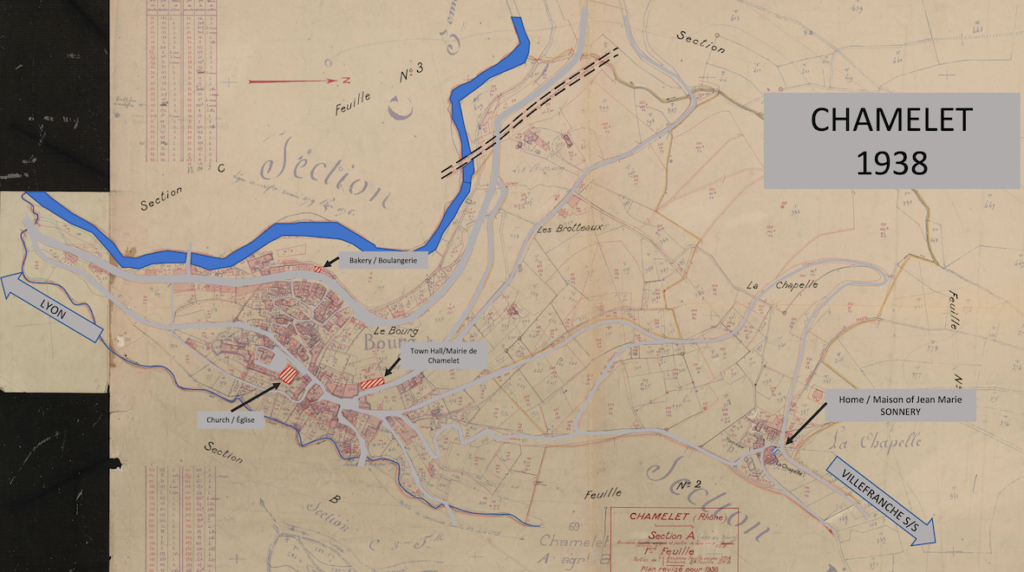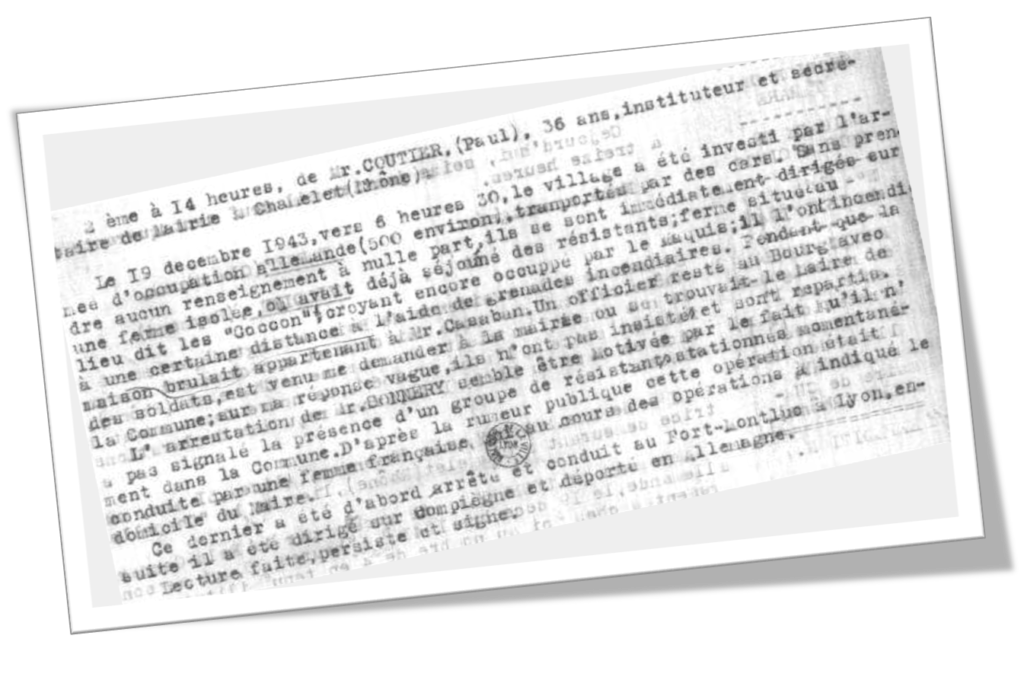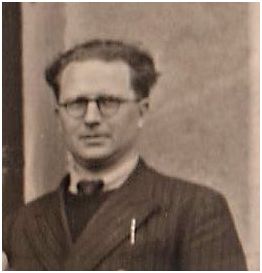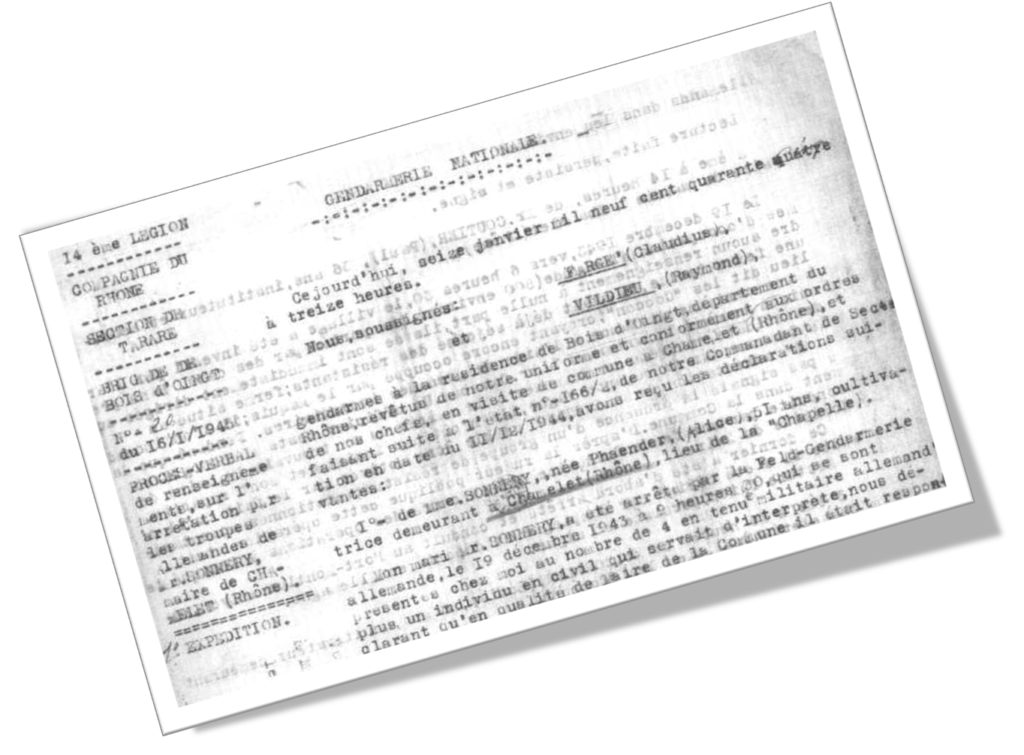Sebastien Jean Marie Sonnery was arrested on 19th December 1943.
This page will detail what happened on that day.

On the morning of Sunday, 19 December 1943, around 300 German soldiers invaded the Village of Chamelet. They arrived in German military lorries and at least one armoured car on half-tracks. Dressed in light green uniforms, they came from two directions, some approaching from the direction of Villfranche-sur-Saône and the others from Lyon.
It is not sure if they set fire to, or launched mortars at, the small barn at Le Cocon.
However, it is certain that they knew exactly what the operation’s objective was in advance. The destruction of the barn at Le Cocon and anyone who was or had been hiding in the building.
Encompassing that primary objective was capturing and eradicating the Maquis who, from the viewpoint of the occupying forces, had been operating unhindered in the region in the past months. Somebody in Chamalet would know where these “terrorists” were now cowering.
Monsieur Paul COUTIER, teacher and secretary to the Mayor.


Monsieur Paul COUTIER was the school’s teacher and the Mayor’s secretary. He lived in one of the apartments above the school and the Mairie. Madame Madeline FOREST and her family occupied the other apartment. She was also a teacher and had been displaced from her home in Francheville because of her communist beliefs.
When Gendarmes, Claudius FARGE and Raymond VILDIEU, working on behalf of Lieutenant MICHARD, Chef du Département de Recherche sur les Criminels de Guerre Ennemis (Head of the Department for Research on Enemy War Criminals), visited Monsieur COUTIER at 2 pm on 16 January 1945, he told them what he knew about the events of 19 December 1943. (1)
He describes how the Village was “invaded” around 6:30 am by what he estimates to be 500 German soldiers. Without stopping to inquire or speak to anyone, they attacked the isolated farm building at Le Cocon, which Monsieur CASABAN owned. This building had until very recently been occupied by the Maquis, although it is not clear if Monsieur COUTIER knew that on the morning of the 19 December or if he was subsequently informed.
The Germans attacked with what Monsieur COUTIER describes as mortars, destroying the building and burning it to the ground.
The commotion awoke many in the Village, the noise of the mortars and the large numbers of German troops.
REF 1
Madame Madeleine Forest-Phily, teacher.
Madame FOREST, whose account is recorded in Roger CHAVANET’s book, describes how a machine gun was set up outside the Church, and one German officer who had remained in the Village with soldiers came to the Mayor’s Office, knocking loudly on the door and demanding to know where the commune’s Mayor could be found.
Either Madame FOREST or Monsieur COUTIER told them he was not there, and they left searching for his home.
REF 2
Antoine LAFAY, Age 8, Alter Boy.
Among those residents awoken by the activity was Antoine LAFAY, age eight years old and son of the Baker, Monsieur Albert LAFAY. Antoine’s Father had close associations with the local Maquis and had been providing them with bread. Antoine was under strict instructions to never speak of the clandestine meetings that took place at the Bakery. It was Sunday, so the Bakery was closed, and Monsieur LAFAY had closed the shutters to their house, which was situated on the main road through the town. He stood behind the shutters, watching through a gap at the street and in his pocket was a pistol. It was unbelievable; with his service gun in his pocket, he was ready to run away if the Germans came for him. The plan was to run out of the back of the house if he needed to escape.
Young Antoine was an alter-boy at the Catholic Church in Chamelet. He was due to do Alter-boy duties at the Church for the Mass, which started at 10 am. As he left the house, he could see Germans everywhere.
Looking back on that day, it is clear to Antoine that if it had become necessary for his Father to make a run for it, his efforts would have been crazy; he would not have got further than 100 metres before being shot.
Antoine crossed the road with his friend, another Alter Boy, and made their way up the hill. So many German soldiers! Strangely, he wasn’t scared, but his friend was. His Father had been taken prisoner in 1940, and perhaps that was impacting him, thinking they had come for him too. To him, “the Germans were all bad people”.
They climbed up the hill and got to the Church; there were just 3 or 4 people for Mass. All the time, Germans were coming in and out of the Church during the service. His friend remained petrified, and so too did Curé J Barre. Their anxiety wasn’t helped when the Germans had set up a machine gun in the town square.
REF 3
Charles CASABAN, Insurance Inspector

Charles CASABAN was an Insurance Inspector who worked in Tarare. His Father owned the farm at Le Cocon. He was interviewed in January 1946 by Jean COTTAREL a Gendarme stationed in TARARE, as was Louis CORGIER who lived in and worked on the farm at Le Cocon, Chamelet, that Monsieur CASABAN owned.
Sometime after 8 am on Sunday, 19 December 1943, Louis CORGIER was home with his wife. Some German Military Police (Feldgendarmerie), part of a contingent he describes as numbering 300 or so other soldiers, came to his house and demanded to see Monsieur CASABAN, who owned the Cocon Barn. (3)
The detachment of soldiers included an interpreter armed with a machine gun. He was wearing a cap of the Alpine Troops and had a white armband.
There was also a young man in civilian clothes. He was about 20 years old and spoke fluent French. Monsieur CASABAN recognised this man; he had passed by the farm the previous Thursday on the 16th “under the pretext of looking for supplies”. During the encounter, this man, whom Monsieur CASABAN refers to in his statement as “the informant”, remained outside in the courtyard.
Monsieur CASABAN knew that the barn, which was now burning, had, until recently, been occupied by the Maquis. The interpreter learned, presumably from “the informant”, that they had visited the farm on Thursday looking for food. When Monsieur CASABAN tried to claim that he thought that they were young workers, the interpreter became agitated.
Monsieur CASABAN had been absent all week apart from Thursday and, on returning on Saturday, had had a brief conversation in passing with the Mayor, Jean Marie Sonnery (they lived relatively close to each other). He tried to assure the interviewer that Monsieur Sonnery was unaware of the Thursday meeting. They pushed and pushed him with this question, wanting to know where these so-called “young workers” were now. They threatened to burn down his house and to burn down the house of Monsieur CORGIER.
Monsieur CASABAN was forced to stand facing a pile of straw with his back to the armed officers as they interviewed Monsieur CORGIER and his wife.
REF 4
Monsieur Louis Corgier - Farmer. Le Cocon, Chamelet

Monsieur CORGIER could neither identify nor know where any of the Feldgendarms threatening him and demanded to know where the Maquis were now hiding out were based. CORGIER was beaten, and as he was kicked out of his house, he noticed that one of the Feldgendarmerie wore an armband with a number on it.
Throughout his ordeal, Monsieur CORGIER and Monsieur CASABAN were understandably terrified. The contingent left the farm a short time later, going to the house of the Mayor and taking with them Monsieur CASABAN.
REF 5
Madame Alice Adèle PFAENDER-SONNERY, La Chapelle, Chamelet

At around 9:30 am the same day, Madame Alice SONNERY was at home with her husband, Jean Marie, who was the Mayor of Chamelet. Four German soldiers came to her house in German military uniform; they were accompanied by an interpreter who was in civilian clothes and Monsieur CASABAN from Le Cocon. (4)
Madame Sonnery describes the soldiers as Feldgendarms said that one of the qualities of the Mayor of the Commune was to report what was happening in his commune, so he should be aware that terrorists were hiding in a barn within the commune of Chamelet.
Jean Marie was asked to confirm if he had met Monsieur CASABAN the day before, which he did. The soldiers then wrote some details from CASABAN’s identification papers, telling him that if necessary, “they would be able to find him”. As Monsieur CASABAN left, he noted in his statement that it was the young man in civilian clothes who was questioning Monsieur le Mayor. (REF 4)
Madame Sonnery went on to describe how Jean Marie did not answer any of their questions; he did not want to denounce the French. The German Feld Gendarmerie arrested Jean Marie on 19 December 1943 at 9:30 am.
Without further discussion, one of the soldiers accompanied him to his room, where he was told to change his clothes, and then they took him away. Madame Sonnery described that all of this occurred in the presence of Monsieur CASABAN, who was told that he would receive news about what would happen to the Mayor. But she said that Monsieur CASABAN never received any information after the arrest of her husband.
Le Jour que mon mari ete arrêté j’ai vu une femme que je crois française et devait être l’Indicatrice, mais elle n’est pas rentrée a la maison et je ne peux vous donner des renseignements sur elle je ne la connais pas.
Alice SONNERY explained that on the day her husband was arrested, she saw a woman who she believed was French and was supposed to be the informant. Still, the woman did not come to her house, and Madame SONNERY could not further explain her identity.
REF 6
Paul COUTIER had also referred to such a woman in his statement.
“D’aprés la rumeur publique cette opération était conduite par une femme française au cours des operations à indique domicile du Maire”
According to public rumour, this operation was led by a French woman during operations at the Mayor’s residence.
Monsieur Louis Corgier - Farmer. Le Cocon, Chamelet
Around 11 am the same day, Monsieur CASABAN returned to Louis CORGIER’s house and told him that he had not been worried and that the Germans had arrested Monsieur SONNERY, Mayor of the Commune of Chamelet, for not selling out the resistance.
REF 5
Antoine LAFAY, Age 8, Alter Boy.
At around the same time, The Mass was finishing, and as Antoine LAFAY and RENARD left the Church, they saw 2 or 3 German cars passing through Les Halles towards where Mousiur Tholin had lived. This was the moment they were taking Monsieur SONNERY away. So they went down to the point where we could see the road and the convoy of German Trucks and a plain car.
Between the Soldiers, he could see one man in civilian clothes, who he was pretty sure was Monsieur SONNERY; he got into one of the trucks with the soldiers.
It was not unusual for the Germans to take hostages and to try and blackmail the Maquis. Instead, they would take a Mayor, a curate, or another important community member from the Village.
It was like a currency that had to be paid. Monsieur SONNERY was a victim, but he knew nothing and had seen nothing related to the Maquis at the Cocon. He didn’t know where the Maquis were, so he paid with his life.
Monsieur Lafay would today tell you that he is pretty sure that the Germans knew that he knew nothing. If they knew that he knew, they would have killed him immediately; he would not have been sent to the camps.
REF 3
RESOURCES:
Header Photo Source:Section A dite du Bourg (ancienne section A et partie de l’ancienne section B) 1ère feuille (parties de l’ancienne feuille unique de la section A et de l’ancienne 2e feuille de la section B). Plan révisé pour 1938.04542, 5564W23Archives du département du Rhône et de la métropole de Lyon
Photo of Paul COURTIER : Patrimoine et Histoire de Champfromier, par Ghislain LANCEL VIA Geneviève Jacquet.
REF 1 : Second Statement of Paul COUTIER 36 years – Teacher and Secretary to the Mayor of Chamelet. 14h00 16 January 1945 by Claudius FARGE and Raymond VILDIEU, Gendarmes in residence Le Bois d’Oingt Rhône.
REF 2 – Memoire of Madame Madeline FOREST-PHILY, contained in “Histoire vécue des maquis de l’Azergues” Page 55 by Roger CHAVANET
REF 3 – Personal Interview of Monsieur Antoine LAFAY 3rd February 2022 by Martin BAKER, Le Gutty.
REF 4 – Statement of Charles CASABAN 45 years, Insurance Inspector, 10:00 27 January 1946 by Jean COTTAREL, Gendarme in residence at TARTARE Rhône.
REF 5 – 2 Statements of Louis CORGIER, 58 Years, a Farmer, Le Cocon, Chamelet
The first 16:00 16 January 1945 by Claudius FARGE and Raymond VILDIEU, Gendarmes in residence Le Bois d’Oingt Rhône.
The Second 10:00 18 January 1946 by René MERCEREAU and Pierre BROCHER Gendarmes in residence Le Bois d’Oingt Rhône.
REF 6 : Statement of Madame Alice Adèle PFAENDER-SONNERY 51 years – Farmer and wife of the Mayor of Chamelet. 13h00 16 January 1945 by Claudius FARGE and Raymond VILDIEU, Gendarmes in residence Le Bois d’Oingt Rhône.
Note of Process Verbal, Chamelet 17 July 1943 – Source Archives Conseil Municipal Maire de Chamelet
NOTES:
Mémorial de l’Oppression.
At the conclusion of WWII the Mémorial de l’Oppression was set up to investiagte War Crimes. The Chef du Département de Recherche sur les Criminels de Guerre Ennemis (Head of the Department for Research on Enemy War Criminals) instigated such an enquiry concerning the deportation of Sébastian Jean-Marie SONNERY, Mayor of Chamelet on 19th December 1943.
Feldgendarmerie carried out the on-the-ground investigation in two phases. The concluding phase took place between August 1945 and February 1946.
The concluding Notes and report are available in the Archives du département du Rhône et de la métropole de Lyon. Ref 3808 W 877.
Most of the timeline and passage of events recounted on this page are sourced from these reports and referenced individually.
Note of Process Verbal, Chamelet 19th May 1935 – Source Archives Conseil Municipal Maire de Chamelet
This post is also available in:
 Français
Français
